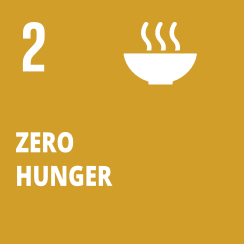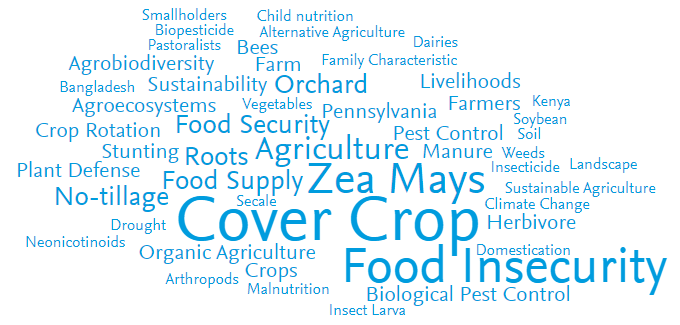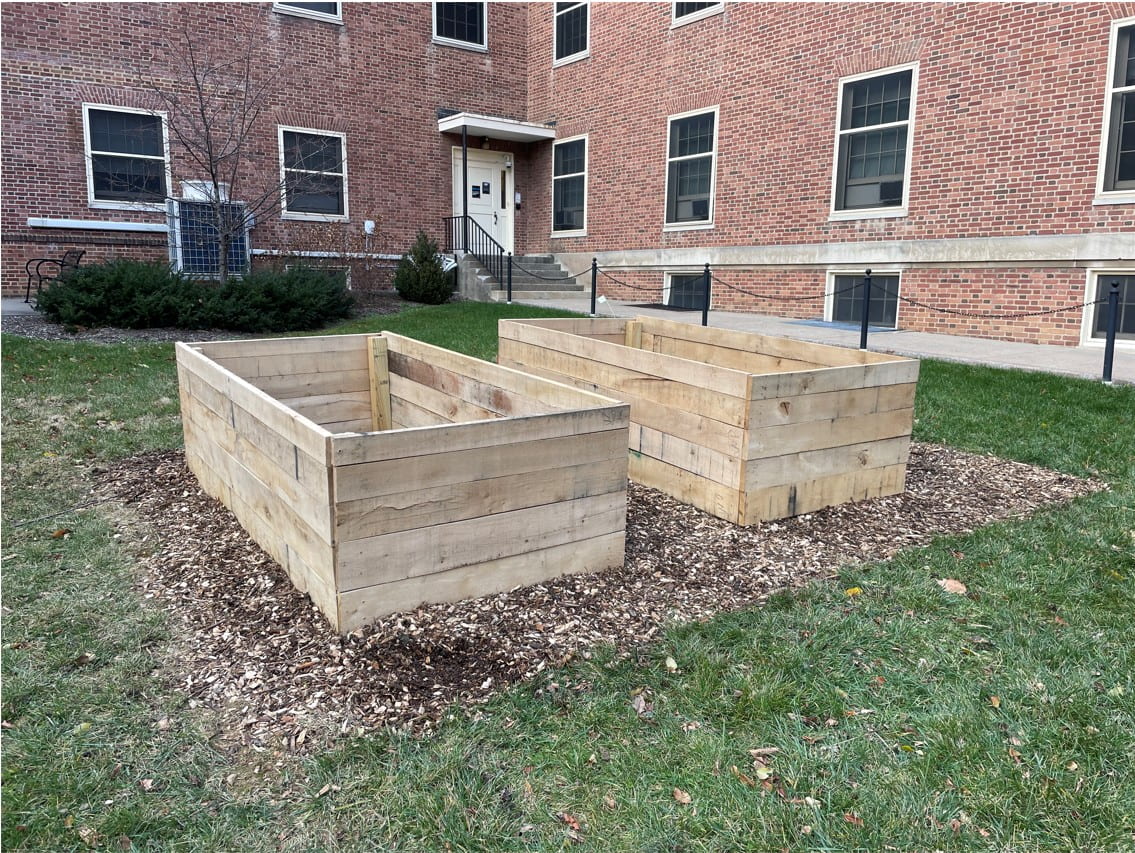
End hunger, achieve food security and improved nutrition and promote sustainable agriculture
Targets for reaching this goal include efforts to end hunger and ensure access to safe, nutritious and sufficient food all year round; ending all forms of malnutrition; doubling agricultural productivity and incomes of small-scale food producers; ensuring sustainable food production systems; implementing resilient agricultural practices; maintaining genetic diversity of seeds, cultivated plants and farmed/domesticated animals; increasing investment in rural infrastructure, agricultural research and extension services, and in technology development and plant and livestock gene banks; correcting and preventing trade restrictions and distortions in world agricultural markets; and, adopting measures to ensure the proper functioning of food commodity markets and their derivatives and facilitating timely access to market information. See below for Penn State’s work on the targets and indicators for this goal.

Source: SciVal.com | This word cloud was created using publications from Penn State researchers
Related News
Supporting Evidence
Penn State does measure the amount of food waste from food served at 9 Residential Dining locations across 5 campus locations: University Park, Harrisburg, Altoona, Behrend, and Berks. Other campuses do not have enough student residents on site or enough on campus population to offer food services. Therefore, we cannot report numbers for the entire university system. The following information reflects only those with dining services.
- According to Residential Dining LeanPath records (LeanPath is the system used to measure pre- and post-consumer food waste), in 2022 food waste totaled 175.23 tons/386,312.2 lbs/175,228.25 kg/79.48 Mt.
- Population on campuses with dining services totaled 59,354.0 FTE (60,722 enrolled).
- Fall 2022 student enrollment across the university – including the law school and medical school – was 80,938.2 FTE (88,116 enrolled).
At the Unviersity Park campus, the food waste was sent to the university compost facility to be turned into soil that is used on university landscaping grounds. The Live On website highlights other Food Waste efforts of Penn State Food Services.
Yes, all Penn State campuses have programs in place to address student food insecurity and hunger.
All Penn State campuses have food pantries on campus or in the community which operate as programs to address student food insecurity and hunger. Most campuses offer either food pantries, food distribution services, and/or campus community gardens.
A complete listing of resources on all campuses can be found on the Food Support and Basic Resources website provided by Penn State Student Affairs.
Each year, a news story about food resources is published for the campus community. For example, in 2022 Penn State News published A student guide to food and housing security resources at Penn State in January, Student guide: Five food and housing security resources to know in September.
Food insecurity resources for student include:
- SNAP: College students may be eligible for expanded SNAP eligibility if they qualify for a work-study work program (even if not participating) and have an expected family contribution of $0 on their federal student aid determination.
- Project Cahir: Can provide up to $100 on their on-campus meal plan account or LionCash+ account for assistance with food purchases. Students can also request pre-packaged toiletries and textbook assistance.
- Student Emergency Fund: Provides short-term financial assistance to students who are struggling with debilitating financial circumstances of an unforeseen nature.
- Free Nutrition Clinic: Students can schedule a free appointment with a registered dietitian who can help with designing a nutritious meal plan within limited financial resources.
- Lion’s Pantry: Provides free food, toiletries and other items to Penn State students.
- State College Food Bank: Provides 12 regular food distributions per year to eligible clients.
- St. Andrew’s Episcopal Church Community Cafe: Provides a free dinner every Thursday from 5-7 p.m.
- Abba Java Coffeehouse: Provides a study spot with free self-serve coffee and tea, food and Wi-Fi (located in St. Paul’s United Methodist Church).
- Since 2020 Penn State has partnered with Swipe Out Hunger to raise greater awareness of student food insecurity and increase the impact of their efforts to raise funds to fight hunger across the University. In April and November of 2022 students at every campus location had the option to donate $5, $10 or $15 when they pay for their meal at any residential dining facility, including mobile orders. Donated funds went toward Penn State’s Student Emergency Fund.

Image source
A Schreyer Scholar and biological engineering major was instrumental in the creation of the Schreyer Pocket Garden, a new two-year pilot program in partnership with the Student Farm Club, the Lion’s Pantry and the University Park Undergraduate Association (UPUA) that will allow students to gain hands-on experience with growing vegetables that will support food security at Penn State.
Yes, Penn State University provides many different interventions are in place to prevent or alleviate hunger among students and staff. For example:
- In the fall of 2022, the university began outreach to Food and Housing Needs Survey participants. Thousands of students across the University completed the Penn State Food and Housing Needs Survey, which closed on Oct. 21, 2021. The Food and Housing Needs Survey results which were shared in the May, 2022 Penn State News story “Penn State shares results of Food and Housing Needs Survey” helped the University learn more about the prevalence of need across each Penn State campus, including Penn State’s World Campus which provides education online. Student Care and Advocacy, a unit of Penn State Student Affairs, coordinated outreach to students at every campus whose survey results indicated a varying level of need related to securing basic resources. The outreach included emails to share resources and individual meetings to provide additional support.
- In February 2021, Penn State released the Food and Housing Security Task Force Report that included a baseline analysis of the issues and recommendations. The food pantries on all campuses are dedicated to supporting food insecure students/staff on campus. A listing can be found on the Food Support and Basic Resources website.
- Former President Eric Barron and his wife Molly made a gift to establish a Food Security Endowment to support the purchase of University meal plans for undergraduates encountering food insecurity.
- Penn State researchers, focusing on Pennsylvania, analyzed survey data to assess the most recent levels of household food security, how food security has changed over the course of the pandemic, and how households in different income brackets have experienced the crisis. They also assessed how families have adapted to food insufficiency by accessing free food and released their findings in a Data Brief titled “Pennsylvania Food Insufficiency Reached New High at the End of 2020.”
Yes, all of Penn State’s dining halls and its hotel restaurants offer vegetarian and vegan options. Customers can view entree cards to see vegan/vegetarian options.
![]()
The Live On site “Special Dietary Needs & Accommodation Requests” features “vegetarianism” resources and the Sustainability page lists other sustainable food choice options including hyper-local produce in the dining commons thanks to a partnership with the Student Farm, Meet Your Farmer interactives, and Local Meal special events to increase education about where food is produced.
Yes, Penn State Campus Dining offers healthy and affordable food choices. The Live On nutrition site provides information about dietician tips and about the Pawsitive Choice program that is designed to help eaters find the better, healthier, “Pawstitive” choice.
The Student Affairs Healthy Eating and Nutrition page offers a number of resources to help students achieve healthy eating habits and maintain proper nutrition including free one-on-one nutrition counseling with registered dietitians and support services.
Residential Dining participated in University Wellness Days by offering special menu features and programming including “fuel for thought” menu items, virtual chef demos featuring local products from the Penn State Student Farm to promote sustainable dining and living, and menu options feature local ingredients such as Pennsylvania mushrooms.
The Registered Dietitian’s Office, which provides nutrition education and support for Campus Dining operations at all Penn State campuses that offer on-campus self-operated dining, provides menu item cards featuring an allergen icon identification system. In addition to allergen information, the cards will feature special diet indicators. Students and guests will be able to tell if a dish contains pork, is meatless, vegan, halal friendly, and/or gluten friendly.
Campus Dining’s menu website features special diet indicators (meatless, vegan, contains pork, halal friendly, gluten friendly), as well as full menus, allergen information, calorie content and other nutritional information.
Yes, Penn State University provides access to knowledge, skills, or technology about food security, sustainable agriculture, and sustainable aquaculture to local farmers and food producers through:
- Penn State Agricultural Extension – A variety of sustainable agriculture programs share skills and knowledge to all 67 counties across the Commonwealth of Pennsylvania.
- The Student Farm offers community outreach and engagement programs to provide diverse opportunities for engagement with sustainability challenges and solutions in food and agricultural systems. The annual Harvest Festival brings together more than a 1,000 people to the farm. In addition, the Student Farm hosts regular webinars
- The Penn State Campus Gardens website provides information about gardens on campuses across the state that aim to educate the campus about our food system and engage the local community in the process.
- Penn State College of Agricultural Science – Ag Progress Days is an annual event that showcases new programs/technology for sustainable agriculture.
- The Symposium on Emergency Food Resilience – this annual event is free and open to campus and community to learn about the latest research on the topic.
- Research – Access to food security and sustainable agriculture knowledge has been made available to a local and global audience by Penn State professors. 2022 publications examples include:
- Food insecurity is associated with higher food responsiveness in low-income children: The moderating role of parent stress and family functioning was published in the journal Nutritional Science
- Farmers’ Perception of Climate Change and Its Impacts on Agriculture was published in the journal Hydrology.
- Meeting global challenges with regenerative agriculture producing food and energy was published in the Journal Nature Sustainability
- Assessment of the effect of urban agriculture on achieving a localized food system centered on chicago, il using robust optimization was published in Environmental Science and Technology in 2021.
Yes, Penn State provides events for local farmers and food producers in order to connect and transfer knowledge by offering many different programs. These include:
- The College of Agricultural Science offers an annual “Ag Progress Days” where local farmers can learn more about new innovations and transfer knowledge/best practices. In addition to the in-person experiences Ag Progress Days includes virtual experiences featuring exhibitors and Penn State Extension programs through on demand webinars and Public Cable Network television coverage.
- The College of Agricultural Science Extension Office offers free educational tools and programs to support local farmers.
- The Penn State Student Farm hosts regular events and webinars to provide information about sustainable agriculture.
- The Department of Food Sciences annually hosts the Penn State-Ingredion Plant Based Yogurt Alternative Short Course on the University Park campus and Virtually.
- allinfoodz, a podcast managed by the Penn State Food Decisions Research Laboratory team, features a variety of topics including “Locally Sourced Food in Restaurants” and “Sustainable Development Goals in Hospitality at the United Nations.”
Yes, Penn State provides access to university facilities for local farmers and food producers that includes:
- Agricultural Analytical Services Laboratory – provides soil, water, plants, and biosolids testing programs and other agricultural materials.
- The Student Farm’s annual plant sale is open to anyone looking to grow their own food.
Yes, Penn State University Dining prioritizes purchases products from local, sustainable sources.
The Penn State Food Services site showcases a list of all the initiatives undertaken by Penn State’s Housing and Foods department including “hyper-local” food features sourced from the student farm, the creamery on campus, and from the university meat labs.
Prioritization of local foods has resulted in 18% of all food purchase coming from local or Pennsylvania suppliers.
Targets & Indicators
Target 2.1: By 2030, end hunger and ensure access by all people, in particular the poor and people in vulnerable situations, including infants, to safe, nutritious and sufficient food all year round
- Indicator 2.1.1: Prevalence of undernourishment
- Indicator 2.1.2: Prevalence of moderate or severe food insecurity in the population, based on the Food Insecurity Experience Scale (FIES)
Target 2.2: By 2030, end all forms of malnutrition, including achieving, by 2025, the internationally agreed targets on stunting and wasting in children under 5 years of age, and address the nutritional needs of adolescent girls, pregnant and lactating women and older persons
- Indicator 2.2.1: Prevalence of stunting (height for age <-2 standard deviation from the median of the World Health Organization (WHO) Child Growth Standards) among children under 5 years of age
- Indicator 2.2.2: Prevalence of malnutrition (weight for height >+2 or <-2 standard deviation from the median of the WHO Child Growth Standards) among children under 5 years of age, by type (wasting and overweight)
- Indicator 2.2.3: Prevalence of anemia in women aged 15 to 49 years, by pregnancy status (percentage)
Target 2.3: By 2030, double the agricultural productivity and incomes of small-scale food producers, in particular women, indigenous peoples, family farmers, pastoralists and fishers, including through secure and equal access to land, other productive resources and inputs, knowledge, financial services, markets and opportunities for value addition and non-farm employment
- Indicator 2.3.1: Volume of production per labor unit by classes of farming/pastoral/forestry enterprise size
- Indicator 2.3.2: Average income of small-scale food producers, by sex and indigenous status
Target 2.4: By 2030, ensure sustainable food production systems and implement resilient agricultural practices that increase productivity and production, that help maintain ecosystems, that strengthen capacity for adaptation to climate change, extreme weather, drought, flooding and other disasters and that progressively improve land and soil quality
- Indicator 2.4.1: Proportion of agricultural area under productive and sustainable agriculture
Target 2.5: By 2020, maintain the genetic diversity of seeds, cultivated plants and farmed and domesticated animals and their related wild species, including through soundly managed and diversified seed and plant banks at the national, regional and international levels, and promote access to and fair and equitable sharing of benefits arising from the utilization of genetic resources and associated traditional knowledge, as internationally agreed
- Indicator 2.5.1: Number of (a) plant and (b) animal genetic resources for food and agriculture secured in either medium- or long-term conservation facilities
- Indicator 2.5.2: Proportion of local breeds classified as being at risk of extinction
Target 2.a: Increase investment, including through enhanced international cooperation, in rural infrastructure, agricultural research and extension services, technology development and plant and livestock gene banks in order to enhance agricultural productive capacity in developing countries, in particular least developed countries
- Indicator 2.a.1: The agriculture orientation index for government expenditures
- Indicator 2.a.2: Total official flows (official development assistance plus other official flows) to the agriculture sector
Target 2.b: Correct and prevent trade restrictions and distortions in world agricultural markets, including through the parallel elimination of all forms of agricultural export subsidies and all export measures with equivalent effect, in accordance with the mandate of the Doha Development Round
- Indicator 2.b.1: Agricultural export subsidies
Target 2.c: Adopt measures to ensure the proper functioning of food commodity markets and their derivatives and facilitate timely access to market information, including on food reserves, in order to help limit extreme food price volatility
- Indicator 2.c.1: Indicator of food price anomalies







